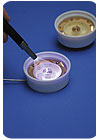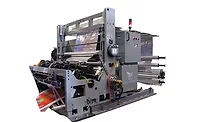The New Cure
Solving
ultraviolet-curable potting and encapsulating problems with shadow-cure
technology.

The main purpose of the potting compound is usually to protect an electronic assembly from moisture, chemicals, dirt or other contaminants. The potting compound may also provide other properties, such as heat dissipation, flame retardance or vibration resistance. Epoxies, Etc. has designed new ultraviolet (UV)-curing materials that offer many advantages over two-component systems. These products are also different than most common UV-curable systems currently available for potting applications.
The 60-7170 UV-curable potting compound and adhesive offers the following benefits.
The new generation of UV-curable products does not have these drawbacks. The main advantages for potting or adhesive applications are the continuation of the curing process in the absence of light without any additional post curing, full surface cure in the presence of oxygen, and better deep curing capabilities of up to one inch.
The new generation of UV-curable resins provides many advantages to companies producing products in the electronic, medical, automotive, aerospace, decorative and optical industries. Productivity may increase with cure times measured in seconds as opposed to hours. There is a reduction in labor costs, inventory, energy costs, production floor space and material waste. These products are also free of solvents and are RoHS compliant.
For more information, contact Epoxies, Etc., 21 Starline Way, Cranston, RI 02921; phone (800) EPOXIES (376-9437); fax (401) 946-5526; or visit www.epoxies.com.

Purpose of Potting and Encapsulating
The potting or encapsulation of electronic components is a common engineering design tool used to protect products from environmental exposure. Potting involves the covering or embedding of an electronic or electrical device. In most cases, an assembly is placed in a case or shell and a liquid potting compound is poured over it. The term ‘encapsulation’ describes a molding or dipping process where there is no case or shell. The assembly is either coated or the compound is poured into a mold and the cured compound becomes the outside of the assembly. The terms ‘potting’ and ‘encapsulating’ are often used interchangeably; both processes will be referred to as potting in this article.The main purpose of the potting compound is usually to protect an electronic assembly from moisture, chemicals, dirt or other contaminants. The potting compound may also provide other properties, such as heat dissipation, flame retardance or vibration resistance. Epoxies, Etc. has designed new ultraviolet (UV)-curing materials that offer many advantages over two-component systems. These products are also different than most common UV-curable systems currently available for potting applications.
Problems with Two-Component Potting Methods
Traditional potting methods are accomplished with two-component epoxy, urethane or silicone materials. Most often, these types of products accomplish the end result of electrical insulation and environmental protection but have inherent production processing problems. Two-component potting compounds have the following processing issues.- Mixing is required
- They can be messy
- They have limited pot life (working time)
- They are slow curing (sometimes 24 hours or more)
- Some require expensive thermal ovens
- Waste is generated from unused mixed product
- Some are hazardous
- High-volume production requires expensive meter mix and dispense equipment
Disadvantages of First-Generation UV-Curable Resins
UV-curable resins have been a desirable alternative to two-component epoxy, urethane and silicone systems, largely due to the fact that they are single component, they cure within seconds when exposed to UV light and they have unlimited working times. However, many “first-generation” UV-curable resins have disadvantages. They are known to leave tacky surfaces due to oxygen inhibition. They have high degrees of shrinkage, are often unable to cure in deep sections and will not cure if shadow areas exist within the potting area. To get shadow areas cured, many products allow for a secondary cure operation, such as heat curing in an oven. This secondary operation slows down the production assembly process and requires energy-consuming ovens. Also, many electronic assemblies contain components that cannot be exposed to the required secondary-cure temperatures.New Technology Overcomes Curing Problems
Epoxies, Etc. has developed products that will solve many of these issues. A new series of UV-curable resins has been developed that will cure in the absence of light after initial UV exposure. These resins do not require a secondary cure operation and provide a smooth, tack-free surface.The 60-7170 UV-curable potting compound and adhesive offers the following benefits.
- No mixing required
- Smooth, non-tacky surface
- Shadow areas cure with sufficient UV exposure
- Low shrinkage
- Excellent adhesion and electrical insulation properties
- Fast cure
- Low toxicity
- Depth of cure up to one inch
The new generation of UV-curable products does not have these drawbacks. The main advantages for potting or adhesive applications are the continuation of the curing process in the absence of light without any additional post curing, full surface cure in the presence of oxygen, and better deep curing capabilities of up to one inch.
New UV-Curable Resins Work with Conventional UV Lamps
The 60-7170 is easily cured with most conventional UV lamps. Peak absorption takes place at 360 nanometers (nm) in the ultraviolet spectrum. Epoxies, Etc. recommends UV-curing equipment based on the demands of a particular potting or bonding application. However, most commercially available spot-cure systems, conveyor systems and black-light lamps have effectively cured these types of products.The new generation of UV-curable resins provides many advantages to companies producing products in the electronic, medical, automotive, aerospace, decorative and optical industries. Productivity may increase with cure times measured in seconds as opposed to hours. There is a reduction in labor costs, inventory, energy costs, production floor space and material waste. These products are also free of solvents and are RoHS compliant.
For more information, contact Epoxies, Etc., 21 Starline Way, Cranston, RI 02921; phone (800) EPOXIES (376-9437); fax (401) 946-5526; or visit www.epoxies.com.
Links
Looking for a reprint of this article?
From high-res PDFs to custom plaques, order your copy today!





